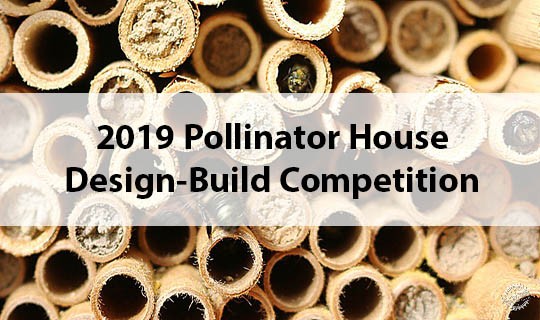
2019 Pollinator House Design-Build Competition
由专筑网缕夕,王帅编译
提交日期:2019年5月15日
注册日期:2019年5月15日
语言:英语
定位:概念型
奖励:请参阅下面的详细信息
类型:开放型
设计一座住宅,建立一个社区!这是一次对外开放的建筑竞赛,要求参赛者设计具备功能性的当代授粉动物的住所,最后拍卖用以支持GBN和BAF的计划。
为纪念布法罗花园落成25周年,布法罗尼亚加拉花园和布法罗建筑基金会联合组织与宣传本次授粉者之家的设计/建造竞赛。竞赛目的是提高纽约西部人民对各种传粉媒介的认识。本次竞赛希望提高人们对各类授粉媒介的认识,并重新定义授粉者之家的概念。竞赛还鼓励所有人参与成为这些重要动物伙伴的设计者和倡导者。
在20世纪和21世纪,由于大量杀虫剂的使用、入侵物种、疾病和寄生虫以及自然栖息地的破坏,授粉者受到越来越多的威胁。群体崩溃(蜜蜂),白鼻综合症(蝙蝠),气候变化(所有传粉媒介)等具体问题导致了整个地区,乃至世界上许多传粉媒介严重的流失。纽约西部的授粉者种族包括:本地蜜蜂、蝴蝶、蝙蝠、鸟类和其他昆虫。
这些动物很重要,因为很多我们赖以生存的植物都依赖于它们来繁殖。根据联合国粮食及农业组织的统计,世界上高达75%的粮食作物在一定程度上依赖传粉媒介来繁殖。
随着传粉媒介动物数量的下降,在花园里建造一个授粉者之家可以给那些独居授粉动物提供一个舒适的家,让它们生活和抚养它们的孩子。授粉者需要根据它们的传统习惯才能繁荣——为了保护本地的栖息地,这些小小的环境拥护者必须需要更大的重要工作空间。通过为传粉媒介提供栖息地,以及种植本地开花植被,提供清洁的水和泥源,并限制农药的使用,我们还可以做很多事情来帮助解决传粉媒介的困境。
竞赛结束后,组织赴负责拍卖所有的作品,从而支持GBN和BAF的计划。每个作品都应满足其目标动物的需求,同时满足室外围栏的基本要求。商业上设计的预制授粉室、用高品质的插图进行艺术装饰,这些都是传统的,而本次竞赛鼓励参赛者提交创造性和创新的设计,打破传统形式。
设计要求
基本要求:
- 合理地保护选定的授粉者
- 为选定的授粉者提供足够的空间来居住
- 提供创意和视觉冲击力的入口
- 考虑合理的安装需求
- 适应组合的GBN和BAF标志(可供下载)
更高要求:
- 独特的制造方法和/或材料选择
- 独特的建筑风格或设计
- 使用回收和/或可持续材料
- 提升设计欣赏和授粉者意识
作品提交
参赛者提交授粉者之家设计及简短的设计说明(250字或更少)。处于后勤需要,房屋的“可移动”形式不能大于12“x 12”x 12“。
参赛者将负责每个参赛作品的所有设计、制作和交付。鼓励多次参赛;但是,必须为每个作品提交单独的报名表。
参赛资格
免费对所有参赛者开放!
鼓励关注气候的建筑师、设计师、园丁、雕塑家、木匠、学生等参与其中,但所有参赛者必须具备合格的施工质量水平,确保授粉者之家的成功建造。
参赛者不需要是纽约州或美国的居民,参赛者必须能够(个人或通过包裹邮寄)将成品交付下地,邮费自理。
注册
2019年5月15日将公布最终建造的授粉者之家参赛作品。在交付前,纽约布法罗的最终建造地点将在新闻稿中公布。在宣布最终位置之前,任何相关的意见书都可以邮件联系至info@buffaloarchitecture.org。注册不需要报名费。
评选标准
鼓励参赛者在确定其设计的形式、功能和风格方面采取广泛的自由度。为确保致力于BAF和GBN的竞争意图,所有设计将根据以下标准进行评判:
- 整体设计的可行性
- 原创性
- 适合传粉媒介
-可持续性
奖励
由纽约西部建筑和园艺界代表组成的评审团,将审核所有关于设计质量、独创性、创造力、可持续性和建造的作品。奖励将最低限度地识别以下类别:
- 最佳团体奖
- 最有可能吸引传粉媒介
- 最佳学生奖(K-12)
作品复制的可能性
虽然不确定或保证,但是为了纪念布法罗花园25周年,需要选择一个或多个复制设计作品。选中作品后,竞赛委员会将联系参赛者进行可能的制造改进。
竞赛网站:https://buffaloarchitecture.org/programs/pro-bono-publico-award/pollinator-house/
Submission: May 15, 2019
Registration: May 15, 2019
Language: English
Location: Concept
Prizes: Please see details below
Type: Open
Design a House, Build a Community! This is an Open, One-stage, Design-Build competition in which entrants are asked to deliver a functional, contemporary pollinator house to be auctioned off to support both GBN and BAF’s programs.
For the 25th anniversary of Garden Walk Buffalo, Gardens Buffalo Niagara and the Buffalo Architecture Foundation are coming together to organize and facilitate a design/build competition of Pollinator Houses. The spirit of the competition seeks to bring awareness to the wide array of pollinators in Western New York. This competition aspires to generate awareness of pollinators of all types and challenge the notion of how these Pollinator Houses can or should look. The competition also encourages all to participate by becoming designers and advocates for these critical animal partners.
Pollinators have been increasingly threatened through the 20th and into the 21st century with the heavy use of pesticides, invasive species, disease and parasites, and loss of habitat. Specific issues such as colony collapse (bees), white nose syndrome (bats), climate change (all pollinators) have led to the severe population loss of many pollinators, across the region, country and world. Pollinators in Western New York include: native bees, butterflies, bats, birds, and other insects.
These animals are important because so much of our food and plants depend on these them in order to reproduce. According to the Food and Agriculture Organization of the United Nations, up to 75 percent of the world’s food crops are dependent in some way on pollinators to reproduce.
With pollinator numbers in decline, having a pollinator house in the garden can help solitary-nesters by providing them a cozy home to live in and raise their young. Pollinators need large areas of habit to flourish– the more that can be done to protect and conserve native habitats, the more space these tiny environmental champions will have to do their important work. By providing habitat for pollinators to dwell, as well as planting a plethora of native flowering vegetation, providing a clean water and mud source, and limiting pesticide use, we can do a great deal to help out with the plight of pollinators.
The conclusion of the competition will result in an auction of all submissions to support both GBN and BAF’s programs. Each entry should address the needs of its target animal while simultaneously addressing the basic demands of an outdoor enclosure. A commercially available, pre-fabricated pollinator house that has been artistically decorated with high quality illustrations is desirable, but entrants are challenged and encouraged to submit, creative and innovative designs that provide a form defying convention.
Expectations
Basic Expectations:
-Reasonably shelter the selected pollinator
-Provide adequate space for the selected pollinator to occupy the house
-Provide creative and visually pleasing entry
-Reasonable installation requirements are accounted for
-Accommodate a combined GBN and BAF logo (available for download)
Heighten Expectations:
-Unique fabrication methods and/or material choices
-Distinctive architectural style or design
-Use of recycled and/or sustainable materials
-Inspire design appreciation and pollinator awareness
Deliverable
A Pollinator House, serving a pollinator identified by the entrant and a brief design narrative (250 words or less). For logistical purposes, the house in its “moveable” form cannot be larger than 12” x 12” x 12”.
Entrants will be responsible for all design, fabrication and delivery of each entry. Multiple entries are encouraged; however, separate entry forms must be submitted for each entry.
Eligibility
Free and Open to all!
Climate conscious architects, designers, gardeners, sculptors, carpenters, students, etc. are encouraged to participate, however all entrants must possess a competent level of construction quality to ensure the successful execution of the Pollinator House.
Entrants are not required to be residents of New York State nor the United States, however, because this is a design-build competition, it is expected that entrants be capable of delivering (personally or by package post) the finished product to the drop off site at their own cost.
Entry Process
Final and constructed Pollinator House entries will be accepted starting at the release of this brief, through May 15, 2019. A final drop-off location in Buffalo, New York will be announced in a subsequent press releases, closer to the final delivery acceptance date. Any submissions desired to be delivered prior to announce of a final location can contact info@buffaloarchitecture.org to coordinate a drop off. No entry fee is required.
Selection Criteria
Entrants are encouraged to take wide latitude in determining the form, function and style of their design(s). To ensure dedication to the BAF and GBN’s competition intent, all designs will be judged on the following criteria:
-Overall design execution
-Originality
-Suitability for pollinator
-Sustainability
Prizes
A jury of esteemed representatives from Western New York architectural and gardening community will be reviewing all submissions for design quality, ingenuity, creativity, sustainability, and execution. Awards recognizing minimally the following categories will be given:
-Best overall entry
-Most likely to attract a pollinator
-Best student entry (K-12)
Possibility of Replication
Although not certain or guaranteed, it is desired to select one or more designs for replication to commemorate Garden Walk Buffalo’s 25th anniversary. The Competition Committee will contact entrants for possible fabrication refinements if the design is selected.
competition’s website: https://buffaloarchitecture.org/programs/pro-bono-publico-award/pollinator-house/
|
|
